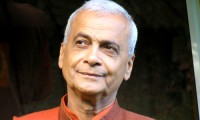by guest author Swami Muktidharma Saraswati
For details of a retreat this weekend at Anahata Retreat on non-attachment, please see the end of this article.
Attachment is one of the main causes in our lives of unhappiness.
Attachment causes fear and fear is the trigger for a lot of other emotions such as anger, stress and lack of satisfaction in life.
When there is attachment to an object, however small, there is fear of losing it.
Attachment to people is equally as challenging and perhaps all the more subtle, as it mixes with our sense of duty and love for family and friends. When we are attached to a person, there is a deep fear that the person may leave us or die.
Fear and attachment coexist. Attachment to name and fame causes fear. Attachment to money causes fear. Clinging to life and the physical body is the main cause of all fears.
In yoga lifestyle and philosophy, it is therefore very important to develop the quality of non-attachment or Vairagya. Many people misunderstand this concept and think that they cannot love anything or be involved in life fully if they are non-attached, however this is not true. If one is non-attached, they are able to be more present with every circumstance and have greater acceptance of whatever comes. The objects and people in their lives become more meaningful because they are able to be present with them, however, when the object or person is no longer with them, the non-attached person is able to remain balanced and positive.
Rather than acceptance of the changing circumstances of life and contentment with what we have when we have it, we spend much of our time either fearful of losing what we think we need or running after what we think we want. Once we get what we want, there is usually something else that glitters in front of the senses and captures the mind. Therefore, we are lost a continual circle of desires which blind us from the deeper realities. We have so many desires, because we are afraid of the present. The ego does not want to see itself, so it keeps creating new diversions for the mind.
However, progress is not the result of fulfilling all the desires that come to the mind. If we analyse the structure of the so-called progressive societies of the West, we find that money and material accumulation are often the cause of misery and unhappiness rather than the glittering gold, they promise to be. By accumulating many external things, we create a jungle, where we get lost with worries and anxieties. We want more and stress ourselves to get more or we worry that our precious object may get lost, stolen, etc.
Ambitions are what motivate us to achieve certain things in life, even to start searching within. However, when the ambitions are directed towards materialistic achievements only, they entangle us in illusion and bring suffering.
Certain types of ambitions are necessary for progress. We can have dreams and desires, but at the same time maintain our awareness so that the results of our efforts do not affect us. When we develop this attitude of non-attachment, we can utilise the energy of dreams and ambitions to be successful and to perform positive actions to uplift our own lives and that of others, however, simultaneously we can see the difficult moments as the greatest lessons for the evolution of our consciousness.
Contentment with whatever life offers allows us to stay present and cope in a skilful way with the ‘menu of the day’. Contentment allows us to develop willpower and mental endurance while giving us an opportunity to be courageous and patient in times of trouble.
Acceptance is the art of living in the present. Every moment of our life is an opportunity to grow. This is why it is so important to embrace each moment with total awareness. Suffering and happiness are both the stepping-stones to climb to the state beyond the mind. Generally we lose our awareness and get carried away by one state of mind or another.
If we get lost in suffering, we create our own misery. If we get lost in happiness and get too excited, then we are bound to pop and come down… just like a bubble of soap. With a balanced mind and an attitude of non-attachment we can approach the situations of life from a different angle and use life for our personal growth.
Life gives us so many opportunities to learn. The deepest learning often comes from what appears to be painful. If we do not accept the learning, we stay lost in an illusion. If we observe life and the situations that “trigger” reactions, it is often the same issue with a different face that comes again and again.
Isn’t it interesting to see how life keeps giving us the opportunity to learn the same lesson until we get it! All this swimming upstream, fighting the flow, creates disharmony on a physical, mental, and energetic level and is the cause of dis-ease. Acceptance and non-attachment brings us towards positivity and gives us glimpses of the true sense of existence. Our peace and joy do not come from the external circumstances, but from the attitude that we develop in front of life’s changing circumstances.
We are able to create our own heaven by living every moment fully. By living fully we gather the totality of our awareness in each moment that comes. This creates the opportunity to see the path of existence clearly.
Yoga is a science that gives us the skills for living with wisdom and experiencing joy. There is a big difference between the ordinary emotion of happiness and the real experience of joy that comes from a deeper level, from our soul perception. The former is momentary and the latter is lasting, permanent.
The practice of acceptance and non-attachment doesn’t need to be practiced on a yoga mat. It is a practice for each and every moment of life.
Attend a retreat this weekend, April 2nd to 5th, 2010
Exploration of Non-Attachment at Anahata Yoga Retreat with Swami Muktidharma & Swami Karma Karuna.
Vairagya, or non-attachment is a powerful practice that we can try to integrate into our daily lives. Meditation techniques and yogic principles can help us to slowly break down the patterns & conditionings that trap us. When the limiting thoughts are gone, we are left with the feeling of non- attachment, of freedom.
Full Retreat (accommodation, meals and program all inclusive) $350 (3 nights)
For Bookings & Enquiries please Email: yoga@anahata-retreat.org.nz or phone: 03 525-9887
Swami Muktidharma is a modern day Yogi, spiritual mentor and world recognized inspirational speaker advocating the concepts and philosophy of Satyananda Yoga.
Dedicating his life to these teachings, including 16 years in India with Yoga Master Paramahamsa Satyananda, he shares a deeply experiential and practical understanding of yoga.
Swami Muktidharma lectures throughout the world and imparts more than 40 years of knowledge. He shares with humour and strength, touching the heart of many aspirants and inspiring them to gradually expand to their full potential.


Awesome article. Love the timeless wisdom of this.